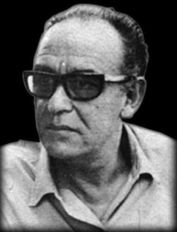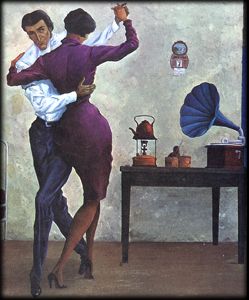By
Sigfredo Pastor, a tango painter

s soon as we scrape in the essence of the porteño, the man of Buenos Aires, the first that comes out is his soul of Tango, that city music and its respectively texture of a sentimental Continent make with loneliness, heaviness, wrangle and nostalgia; feelings that only can repair a big love.
 As Alfredo Le Pera and Carlos Gardel said: «With Her next to me I did not see your sadness, your mud and misery, she was my light...» and that love, for a more dramatism of the tango, uses to be always the one that was not, the unfinished passion, the broken idyll: that love constitutes the insuportable agony of the separation when all was happyness. Has the passion existed sometime in other way in the literature?
As Alfredo Le Pera and Carlos Gardel said: «With Her next to me I did not see your sadness, your mud and misery, she was my light...» and that love, for a more dramatism of the tango, uses to be always the one that was not, the unfinished passion, the broken idyll: that love constitutes the insuportable agony of the separation when all was happyness. Has the passion existed sometime in other way in the literature?
It results unquestionable that the madness of the love, its franzy never stays the same for all the life of the couple. The untied love between Romeo and Juliet stop and grown after the death of both, the same happens with Cleopatra and Marco Antonio, and is also the death who finished the passioned love of Margarita Gauthier and Elizabeth Browning, the idyl between Abelardo and Eloisa grows with the agony of the separation. Rodolfo from Habsburgo and Maria Vetsera decided to self —murdered together in Mayerling—, Jane The Mad cried for ever the death of Felipe The Beautiful. No one of these passioned relations had a large and deep existence that with the time could change the things. All of these loves remained mutilated by the fatality, and therefore their perseverance and that's why they are called: The love that wasn't.
No song of no one folklore of the world sings to the misfortune of the imposible love in the way that the Tango does, saying more the Tango created a word that is exclusive and has not equal in spanish: metejón, this word as Enrique Santos Discépolo sings means to surround oneself with the thing that could not be, to love the suffer of love, to remember, to be homesick, to believe that all the past was better, to feel, to think, to meditate in what is unrecoverable.
The Tango, in the extension of its Theme succors other times to the rebelliousness, but this expression constitutes only the lonely offensive of the disappointment, a solitary protest, a mystic wrangle in which the tango man consoles himself by explaining himself too that the misery, the exploitation, the offense or the unfounded aggression of the dominators are unsolvable. That lament limited to the little space of the tango letter Is emitted only as a personal alleviation that gives a recompense to the author, never goes far away from the individual satisfaction, and as a social lament has the same minim repercussion of a dog bark to the moon, that howling clamor only represents the ignored and deep lament of the animal against the dead love. This essence super exclusionist is a privilege that only has the danced tango, in which neither the man or the woman can separated themselves of the concentration that wraps and amalgamates them, realizing a majestic ritual that no other dance in the world could offer. Therefore the Tango has been considerated the grate dance of our epoch, the choreography ceremony in which the human kind put in play the interest of its kind by perpetuating itself by the procreation, there is where the couple kindles the impulse of the unique act able to bring them to the sensation of eternity that gives the descendence.
Sigfredo Pastor, before of being an artist, man of Buenos Aires until the most secret nerve of his entrails, dedicated exclusively to a pictorial theme of deep tango root, draws in his pictures, a universe that is an exact reflex of our popular music spirit.
He affirms in his pictures the vigor of the interlace dance by forming or fusing the couple in only one figure as a compliment of a malevolent neatness and sculptural plasticity, that for its vibrating action seems to be dedicated in fixing itself in an indefinite way in the time.
He shows with notable expression and also with a prepotent filigrane all what our popular city music exhibits as virile and brave. That erotic impulse of ferocious contexture has its solidness in the courage of ignored but real epopees with knife combats in which the suburb was its past and never forgotten scene. For the surroundings, after the dead of the life in liberty at the field arrived the fired and almost conquered exiled gauchaje.
 After the renascence of the tango in the city, comes the impressive ritual of the danced tango, that is here in the brush of Pastor which is overflowed of excitation and solemn brown study surmounted by gross borders or thin arabesques, that for their position and aptitude show the overflow sacred fire, the mystic concentration that is required to make the sublime act of dancing the tango. After this, or as an indispensable part of all, like an inevitable stroke, like a fundamental detail, the polichromic mise in scene jump the clothes, coats, pants, blouses, skirts, handkerchiefs or the chambergos that seem to be join to the skin. They all show folds, sinuosities, poultry dealers that serve as refuge, home or covert of a choreography that fuses the bodies in an erotic plot and establishes the previous step of the opened corolla to the pollen, and here we find as a crashing of the rite a display of movements in legs, arms and hips, which are all a prepotent ostentation that constitutes other essential part, that for its genuine gesticulatory pompous could graphic the cry. Besides this, the tango in order to establish its legitimate exactitude and its identity requires a real scene with authentic proper material, without this the tango could lose its taste, that its roots offer as urban folklore far away from the false feerie of the Cabaret.
After the renascence of the tango in the city, comes the impressive ritual of the danced tango, that is here in the brush of Pastor which is overflowed of excitation and solemn brown study surmounted by gross borders or thin arabesques, that for their position and aptitude show the overflow sacred fire, the mystic concentration that is required to make the sublime act of dancing the tango. After this, or as an indispensable part of all, like an inevitable stroke, like a fundamental detail, the polichromic mise in scene jump the clothes, coats, pants, blouses, skirts, handkerchiefs or the chambergos that seem to be join to the skin. They all show folds, sinuosities, poultry dealers that serve as refuge, home or covert of a choreography that fuses the bodies in an erotic plot and establishes the previous step of the opened corolla to the pollen, and here we find as a crashing of the rite a display of movements in legs, arms and hips, which are all a prepotent ostentation that constitutes other essential part, that for its genuine gesticulatory pompous could graphic the cry. Besides this, the tango in order to establish its legitimate exactitude and its identity requires a real scene with authentic proper material, without this the tango could lose its taste, that its roots offer as urban folklore far away from the false feerie of the Cabaret.
Pastor gives to the tango his most authentic view: the yard, that microcosm that synthesizes the life at the suburb with its loaded hope of miracles, the board with squire tiles in the chess where the valiants made more than one mortal play.
Upon the pink or yellow walls of the borders of this yard climb the twining plants and honey —suckles or grow honey— jars. We find also here the eaves in order that the old and warm Continent could have as our cried Cátulo Castillo said: «Fresh of Shadow and the friend Mate» could round warm and soft at the circle formed by the cordial withy arm chairs, more generous and majestic than a tree trunk.
Here, in the same old yard is the hillock with the little window, where in a small pot has grow a flower swollen of the same courage of this miserable owner, that flower that will survive innumerable inclemencies and postponements. Inside, the warming pan rules the winter, and the summer as an inextinguishable votive fired flame holds the feeling of love, which absent or present, will be always alive.
Upon the old walls of an old room the porteño re-established, like an altar, the pantheon of his heroes: the smiling side face of Gardel, the neatness boxing of Firpo, Justo Juárez or El Mono Gatica and the white and blue football selection of the great and fraternal regional fights against the neighbors Uruguayans.
And in the forum as the drop scene of the representation from the legendary sainete criollo, so close to the scene of the tango we have an almost unreal door which symbolizes the old large front door of the tenement-house where the friends of Alberto Vaccarezza, Carlos Mauricio Pacheco and Roberto Lino Cayol stayed upon to contemplate the old scene of the losed love after the shadow return.
This same large front door which is open day and night offers the overpowering of the street lamps marking a large line of lights that goes downtown so that the most beautiful girl of Chiclana could follow her complimenting the effort of becoming herself in the mythological Esthercita and the simple Margaret became to be called Margot.
This line of lights rotates the crank handle of the little organs milling in the tango a melancholic load of absents, homesickness and vain dreams to repeat one more time its praised and unfinished thematic. the love that wasn't. That impossible make of gray afternoon, unmeeting, absent date and round corner without her, that for Sigfredo Pastor and for me will always be the voice of Buenos Aires. All this is to say: Tango.
Published at Buenos Aires, June 1978.